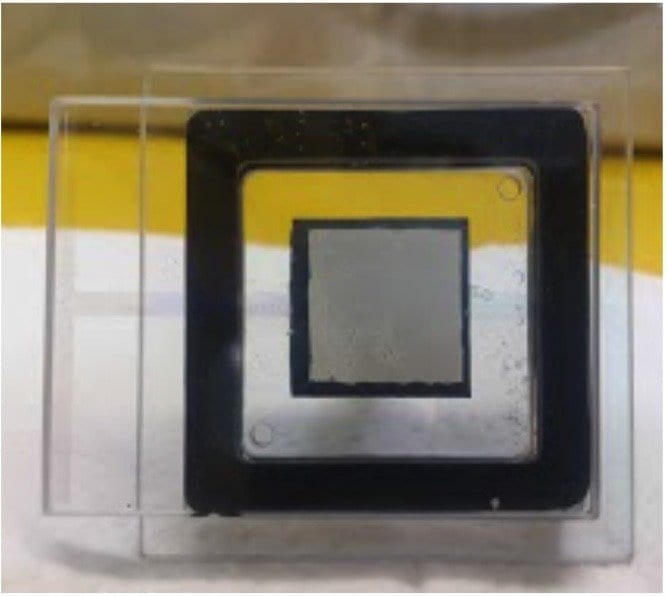
Planar light source device: Front
A new type of energy-efficient flat light source based on carbon nanotubes with very low power consumption of around 0.1 Watt for every hour’s operation–about a hundred times lower than that of an LED.
Even as the 2014 Nobel Prize in Physics has enshrined light emitting diodes (LEDs) as the single most significant and disruptive energy-efficient lighting solution of today, scientists around the world continue unabated to search for the even-better-bulbs of tomorrow.
Enter carbon electronics.
Electronics based on carbon, especially carbon nanotubes (CNTs), are emerging as successors to silicon for making semiconductor materials. And they may enable a new generation of brighter, low-power, low-cost lighting devices that could challenge the dominance of light-emitting diodes (LEDs) in the future and help meet society’s ever-escalating demand for greener bulbs.
Scientists from Tohoku University in Japan have developed a new type of energy-efficient flat light source based on carbon nanotubes with very low power consumption of around 0.1 Watt for every hour’s operation–about a hundred times lower than that of an LED.
In the journal Review of Scientific Instruments, from AIP publishing, the researchers detail the fabrication and optimization of the device, which is based on a phosphor screen and single-walled carbon nanotubes as electrodes in a diode structure. You can think of it as a field of tungsten filaments shrunk to microscopic proportions.
They assembled the device from a mixture liquid containing highly crystalline single-walled carbon nanotubes dispersed in an organic solvent mixed with a soap-like chemical known as a surfactant. Then, they “painted” the mixture onto the positive electrode or cathode, and scratched the surface with sandpaper to form a light panel capable of producing a large, stable and homogenous emission current with low energy consumption.
“Our simple ‘diode’ panel could obtain high brightness efficiency of 60 Lumen per Watt, which holds excellent potential for a lighting device with low power consumption,” said Norihiro Shimoi, the lead researcher and an associate professor of environmental studies at the Tohoku University.
The Latest on: Carbon electronics
[google_news title=”” keyword=”Carbon electronics” num_posts=”10″ blurb_length=”0″ show_thumb=”left”]
via Google News
The Latest on: Carbon electronics
- Lawsuit filed in carbon monoxide poisoning deathon April 25, 2024 at 7:00 am
The estate of a Union man who died in 2021 from carbon monoxide poisoning is suing his former landlord, claiming that carbon monoxide detectors were missing from the property and ...
- Imagine powering your phone with carbon dioxideon April 25, 2024 at 5:00 am
The carbon-negative power generator, reported in the journal Nature Communications, is only a small proof-of-concept laboratory-scale device right now. But it could pave the way towards a new ...
- Carbon Nanotubes Market Size, Opportunities, Share, Growth, Regional Trends, Key Segments, Graph and Forecast to 2028on April 23, 2024 at 10:35 am
Carbon Nanotubes Market by Type (Single Walled & Multi Walled), End Use Industry (Electronics & Semiconductors, Chemical Materials & Polymers, Structural Composites, Energy & Storage, Medical), Method ...
- Scientists stencil-paint carbon nanotube components for flexible transparent electronicson April 23, 2024 at 9:23 am
Researchers from Skoltech, MIPT, and elsewhere have found a fast and inexpensive way to create geometric patterns in carbon nanotube films. The resulting films turned out to have superior properties ...
- Chinese company issues carbon-neutral earphoneson April 22, 2024 at 8:19 am
Established in 1997 mainly as a supplier for global brands, Grandsun launched its Cleer brand in 2012. The company is committed to zero-carbon production partly as a response to China's calls for its ...
- Carbon Steel Market Expected to Witness 4.0% CAGR, Reaching US$ 1,560.4 Billion by 2033on April 21, 2024 at 7:44 pm
The global carbon steel market value is forecast to increase from US$ 1,050.8 billion in 2023 to US$ 1,560.4 billion by 2033. Over the assessment period, global demand for carbon steel is projected to ...
- Commentary: Malaysia’s difficult path to a low-carbon economyon April 20, 2024 at 3:00 am
Malaysia’s climate action commitments are vital, but difficult to achieve. A three-pronged approach opens possibilities to be a low-carbon economy, says ISEAS-Yusof Ishak Institute’s Dr Vinod Thomas.
- New study examines the increased adoption of they/them pronounson April 19, 2024 at 10:30 am
People are using "they/them" pronouns more often according to a new study by the University of North Carolina at Chapel Hill.
- Used electronics can power sustainable ESG growthon April 18, 2024 at 11:45 pm
The focus on Environmental, Social, and Governance (ESG) factors has become increasingly prominent. From reducing carbon footprints to fostering social equity, organisations are aligning their ...
- Demystifying low carbon steel manufacturingon April 17, 2024 at 12:42 am
Sponsored: The challenge of decarbonizing heavy industry is significant. But “hard-to-abate” can be conquered with the right mix of approaches—and mindset.
via Bing News









